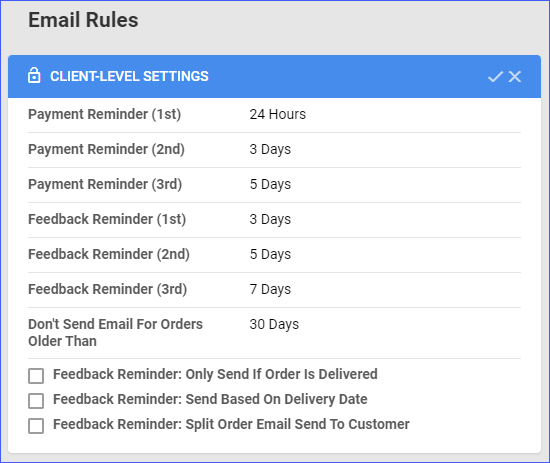Overview
The Email Rules page in Sellercloud allows you to configure automatic email notifications triggered by specific events. There are two types of email rules: Client-Based and Company-Based. The client-based settings act as global preferences that apply across all companies within your account, while the company-based rules are set for each company or sales channel separately.
Prerequisites
To send emails based on email rules, the following conditions must be met:
- Open a ticket with Sellercloud Support to confirm that the following Windows Services are running on your server.
- eBayFeedbackService for Feedback emails
- BRSOrderEmailService for Order Shipping Confirmation emails
- Configure your SMTP Settings. Valid SMTP credentials are required.
- Assign Email Templates to any related email types.
Configure Email Rules
To configure your Email Rules, navigate to Settings > Email > Email Rules. Here you can edit both Client-Level and Company-Level settings.
Client-Level Settings
Click the Edit button of the Client-Level Settings panel and adjust your preferences as needed. Here you can configure the frequency of Payment and Feedback Reminders, as well as additional rules. You can set them in hours or days.
- Payment Reminder — Sent for unpaid orders based on the Creation Date.
To successfully send payment reminders, you must assign Email Templates for all three email types: PaymentReminderFirst, PaymentReminderSecond, and PaymentReminderThird. - Feedback Reminder — Sent for shipped orders based on the Ship Date to request feedback from the buyer.
To successfully send feedback reminders, you must enable the Feedback Request checkbox for your desired companies and assign Email Templates for all three email types: FirstFeedbackReminder, SecondFeedbackReminder, and ThirdFeedbackReminder. - Don’t Send Email For Orders Older Than — Emails will not be sent for orders created before a specified period.
- Feedback Reminder: Only Send If Order Is Delivered — Sent for shipped orders based on the Delivery Date instead of the Ship Date. Feedback reminders will only be sent when the order’s Delivery Status is set to Delivered.
- Feedback Reminder: Send Based On Delivery Date — Feedback reminders will be sent based on the Delivery Date in Sellercloud.
- Feedback Reminder: Split Order Email Send To Customer — Will send an email directly to the customer associated with the order if the order is a Split Order.
If all criteria are met, in the below example, Sellercloud will send a feedback reminder for an order after 3 days, a second reminder after 5 days, and a third reminder after 7 days. You can also enable the option to only send a feedback request if the order has been marked as delivered. 
Company-Level Settings
You can configure company-level email rules for each of your integrated sales channels. Select your desired company from the dropdown menu and enable the checkboxes below to choose which emails should be sent out for each channel:
-
- Order Welcome — This email is triggered when a new order is created in Sellercloud. It corresponds to the OrderWelcome email type on the template assignment page.
- Shipping Confirmation — This email is triggered when an order is shipped. It corresponds to the OrderShippedConfirmation email type.
- Feedback Request — This email is triggered for shipped orders based on your Feedback Reminder Preferences. The corresponding email types for each feedback reminder are FirstFeedbackReminder, SecondFeedbackReminder, and ThirdFeedbackReminder.
Some channels do not provide customer emails and may not want merchants to reach out to them directly. For example, Amazon automatically sends feedback requests to the customer, so there is no need to configure additional reminders for Amazon in Sellercloud.
- Order Undelivered — This email is triggered for orders that are marked as undelivered. It corresponds to the OrderUnDelivered email type.
- Payment Confirmation — This email is triggered when the order is paid. It corresponds to the OrderPaymentConfirmation email type.

